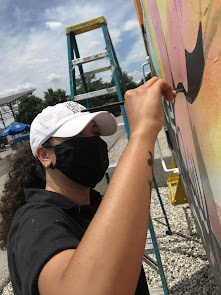Artist Spotlight: Jaz Erenburg
Jaz is drawn to street art in particular because she believes it offers a higher level of public accessibility than many other mediums. Based on her own self-admittedly high standards for defining the artform, Jaz professes that public art means "a lot more than just painting a wall," adding that "it's really about engaging with community, really figuring out what they're dealing with, what their issues are, and how I can come in and make a sort of artful solution." Jaz approaches her projects with the intent of finding these artful solutions, and believes that her work can help facilitate dialogues with communities whose voices need to be heard.
When asked how she applied this approach the B&O Street Art Project, Jaz admits that she had to make adjustments to her typical process. But in seeking an entry point through which to connect her art to the railroad, Jaz found herself fascinated by the history of train-hopping "hobos," a term which has historically been used for migrant workers who hopped trains in search of work. From there, Jaz grew deeply interested in the hieroglyphic language of Hobo Code, and found in it an opportunity to design a piece which speaks not only to the history of the railroad, but also to the role of language in the creation of communities, and the function of art as a "bonding language" for marginalized communities. In speaking to the importance of displaying street art at the B&O Railroad Museum specifically, Jaz explains that for this mural, she sought immersion in "the culture of what [the railroad] was built in, rather than how it's perceived now." While the hobo hieroglyphs that constitute the background of Jaz's mural may be largely esoteric to many viewers, Jaz believes that that they will nonetheless capture the intrigue of those unfamiliar. It is certainly easy to see how fascination can function as a starting point for engagement with critical and often overlooked aspects of the railroad's history.
Jaz's background as an educator plays a huge role in her artistic process, and as such, research is one of her first steps in designing any new piece. In the case of the B&O Street Art Project, which prompted artists to design pieces on the theme of "connectedness," Jaz was seeking a connection between street art culture and railroad history. She found this "missing piece" in what she describes as a "loose" connection between vagabond hieroglyphs and modern-day tagging. For Jaz, Hobo Code and street art both represent some of the only accessible means "of communicating, of expressing" for marginalized communities. When asked how she would respond to potential detractors and those who see street art as little more than vandalism, Jaz speaks to the innate connectiveness of trains, a sense that she feels may be lost when one looks at trains exclusively in a Museum, or "when you can only see one station and, like, one part of it," rather than the many places that any given train goes to, from, and through.
The focal point of Jaz's piece is undeniably the interlocked pair of hands at its center, and Jaz explains that these hands, which she calls "ancestral hands," are a staple of her work as a whole. They are intentionally "abstract, there's no skin color, they blend into each other." She sees them as "a concept that holds a cultural history and a culture knowledge that's hard to acknowledge" and says that as a symbol, "it's even attached to ancestral trauma, and how that directs you, and how that impacts your core values as a person and the core values of your community." To Jaz, who describes herself as a "spiritual person" who does not "necessarily believe in god," her signature Ancestral Hands represent not just the idea of connectedness, but the guiding forces which shape and impact the fates of entire communities and the lives of the individuals who comprise them.
When it came to the actual process of creating the piece, Jaz electronically projected her design onto the caboose (a smaller canvas than she's used to for murals), first sketch-painting the outline of the mural, then filling it out with additional layers of paint.
Jaz wants those who see her mural at the Museum to walk away having learned something new, and with a willingness to be "more open-minded, even if it's just a step closer."
Follow Jaz on Instagram @jaz_erenberg

No comments:
Post a Comment